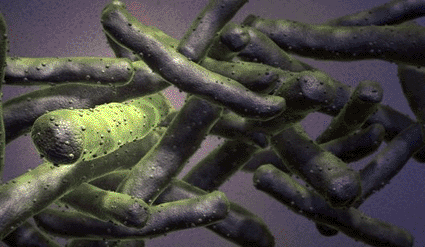Interferon-Gamma Pathway Activates the Immune System Against Tuberculosis
By LabMedica International staff writers
Posted on 05 Jan 2010
A recent study revealed the molecular mechanism whereby interferon-gamma regulates the immune response that protects the body from the bacterium that causes tuberculosis, Mycobacterium tuberculosis.Posted on 05 Jan 2010
Interferon-gamma has an antiproliferative effect on many tumor cells and inhibits intracellular pathogens such as Toxoplasma and Chlamydia, at least partly because of the induction of the enzyme indoleamine 2,3-dioxygenase (IDO). IDO, which catalyzes conversion of L-tryptophan to N-formylkynurenine, is an immunomodulatory enzyme produced by some activated macrophages and other immunoregulatory cells. IDO is the first and rate-limiting enzyme of tryptophan catabolism through the kynurenine pathway, thus causing depletion of tryptophan, which can inhibit growth of microbes as well as T cells.

Image: A stylized scanning electron microscopic image of mycobacterium tuberculosis (Photo courtesy of Medical RF.com).
Investigators from the New York University School of Medicine (NY, USA) worked with a chimeric mouse model whose bone marrow contained lung epithelial and endothelial cells that were not responsive to interferon-gamma. These animals as well as a control group of normal (bone marrow containing interferon-gamma responsive hematopoietic and nonhematopoietic cells) mice were infected with M. tuberculosis.
Results published in the December 18, 2009, issue of the journal Immunity revealed that the bone marrow chimeric mice with interferon-gamma-unresponsive lung epithelial and endothelial cells exhibited earlier mortality and higher bacterial burdens than control mice. Molecular analysis showed that the chimeric mice underexpressed indoleamine-2,3-dioxygenase in lung endothelium and epithelium, and overexpressed interleukin-17 (IL-17) with massive neutrophilic inflammation in the lungs. In the control animals, the products of IDO catabolism of tryptophan selectively inhibited IL-17 production by Th17 cells, by blocking the action of IL-23. This pathway was not present in the chimeric mice, resulting in a much higher degree of inflammation.
"Through research on tuberculosis, we discovered a new way that the immune system response is controlled,” said senior author Dr. Joel Ernst, professor of medicine at the New York University School of Medicine. "Further study may reveal treatments that could be useful in control of inflammation and tissue damage in certain infections and autoimmune diseases.”
Related Links:
New York University School of Medicine













